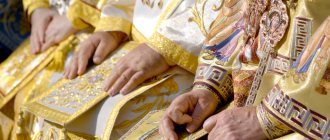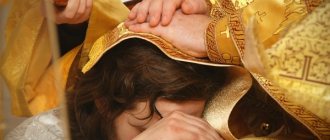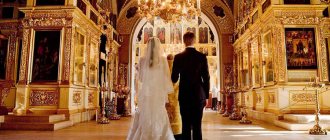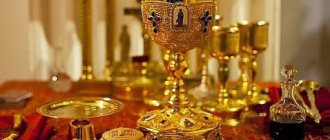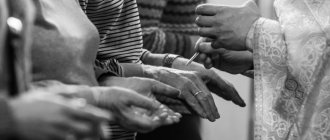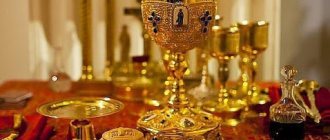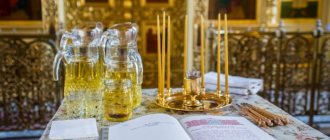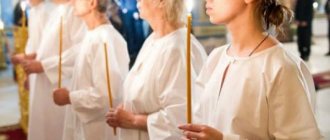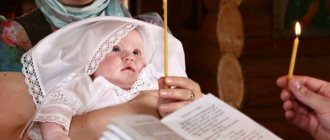Priesthood is a sacrament in which the Holy Spirit, through the laying on of holy hands, appoints a church minister to perform the sacraments and shepherd the flock of Christ. Orthodox teaching views the Priesthood as one of the seven church sacraments. Its basis is divine establishment, historical continuity and the unconditional necessity for observing the general order of statutory church life.
On the greatness of the Christian priesthood, St. John Chrysostom wrote this:
The priestly service is performed on earth, but according to the heavenly order, and very justly, for neither man, nor angel, nor archangel, nor any other created force, but the Comforter Himself established this order and made people, still clothed in flesh, representatives of the angelic ministry... The priest is coming sending down not fire, but the Holy Spirit." The priesthood is so important for Orthodoxy that to the question: “When is a local church a Church?”, the answer is given: “When there is a priest, there is a local church.
The Church claims that She can be without churches and monasteries, without rituals and church utensils, but not without the priesthood. Thus, all local churches are concentrated around their pastor, since he only has the right to perform the sacraments and sacred rites.
History of the establishment of the priesthood
The Lord established the Priesthood in the Old Testament, as Moses tells us:
And take unto you Aaron your brother, and his sons with him, from among the children of Israel, that he may be priest unto me, Aaron, and Nadab, and Abihu, and Eliazar, and Elithar, the sons of Aaron (Ex. 28.1)
The Lord commanded Moses to appoint the tribe of Levi to serve at the tabernacle and assign the high priest, priests and Levites, that is, servants, to the tabernacle. The high priest corresponded to our bishops (bishops), the priests to the priests, and the Levites to the deacons and servants.
In the New Testament, the Sacrament of the Christian Priesthood was established by the Lord Jesus Christ Himself through St. the apostles - His closest disciples and associates. Hence one of the most important canonical teachings of St. The Church is the provision of Apostolic succession, i.e. that through the descent of the Holy Spirit the apostles received grace to perform church sacraments, as well as the authority to convey this highest grace to their followers.
“Apostolic succession is a divinely established way of preserving and transmitting hierarchical service in the Church from the holy Apostles through the Sacrament of the Priesthood. Apostolic succession presupposes not only visible expression in the series of episcopal consecrations (ordinations), but also the transfer of the grace-filled gifts of the Holy Spirit, on which the hierarchical ministry of the Church is based.
According to the testimony of the Holy Scriptures, the holy Apostles, who received the fullness of this ministry from the Lord Himself, after the descent of the Holy Spirit (John 20:21-23; Matt. 28:19-20; Mark 16:15-16; Luke 24:47 -49; Acts 1:8) ordained the first bishops (Acts 14:23; 20:28; 2 Tim. 1:6, etc.) and commanded that the fullness of the grace-filled gifts of the church hierarchy be transmitted through the Sacrament of episcopal ordination (1 Tim. 5:22; Titus 1:5). Apostolic succession is attested to by the most ancient Church Tradition: St. Irenaeus of Lyon, St. Clement of Rome, Blessed. Jerome, Tertullian and others." (Catechism).
It is believed that the idea of apostolic succession was first formulated by Clement of Rome (1st century, apostle of seventy) in his first letter to the Corinthians:
And our apostles knew through our Lord Jesus Christ that there would be contention about the episcopal title. For this very reason, having received perfect foreknowledge, they appointed the above-mentioned ministers, and then added a law, so that when they died, other proven men would take over their ministry. So, we consider it unfair to deprive the ministry of those who were appointed by the apostles themselves or after them by other venerable men, with the consent of the entire Church, and served the flock of Christ blamelessly, with humility, meekly and blamelessly, and, moreover, for a long time received approval from everyone. And no small sin will befall us if we deprive those who bring gifts without reproach and holyly of their episcopacy.
About the sacraments. Sacrament of Priesthood
THE CONCEPT OF THE SACRAMENT
The priesthood is a sacrament in which, through priestly ordination (ordination), the Holy Spirit descends on the rightly chosen one and instructs him to perform the sacraments and shepherd the flock of Christians (Catechism).
The Sacrament of the Priesthood, like other sacraments, has two sides: external and internal.
External side
The sacrament consists of holy ordination with prayer. The use of ordination as a symbol of blessing and transfer to another of the power received from God is found in the Old Testament (Gen. 48, 14; Num. 27, 23; Deut. 34, 9). In the Christian Church, from the very beginning of its existence, ordination is a necessary accessory to the sacrament of the Priesthood. The holy apostles, having received power from Jesus Christ Himself, passed it on to their successors in no other way than through ordination (Acts 6:6; 13:3; 14:23), and commanded them to do the same in turn (1 Tim. 4 , 14; 5, 22; 2 Tim. 1, 6). The Orthodox Church has always followed this commandment with all strictness.
The inner side of the sacrament
constitutes the grace of the Holy Spirit, taught to persons ordained as deacon, priest and bishop. Already in the Holy Scriptures it is spoken of the election of certain persons to these ministries and the teaching of the Holy Spirit to them through the laying on of hands (Acts 6:10; Eph. 3:2; 1 Tim. 4:14; Acts 8:29; 13:2, etc. .). And the Church has always confessed that in the sacrament of the Priesthood, the ordained person is given the special grace of the Holy Spirit to serve the Church, and expresses his faith in prayers used during initiation to different degrees of the priesthood.
ESTABLISHMENT OF THE SACRAMENT
This sacrament was established by the Lord Jesus Christ Himself, who chose the apostles from among His listeners and disciples and gave them the authority to teach and perform the sacraments, and upon His Ascension He sent down to them the Holy Spirit, endowing them with the powers necessary for their service (Acts 1:8; 2, 4). Since then, the kindled Divine fire of grace of the Holy Spirit has been kept in the Church and has been successively passed on from generation to generation. A visual and symbolic sign of this successive connection between the gifts of grace and the power of the priesthood is the laying on of hands, which is used to bring down the grace of the Holy Spirit to the ordained persons.
THE CONCEPT OF CHURCH CLERIC PERSONS:
PRIESTS AND CHURCH OFFICERS
Persons over whom the sacrament of the Priesthood is performed - clergy - are of three degrees in the Church: bishop, priest and deacon.
Initiation into these degrees of the church hierarchy takes place after passing through the lower degrees of clergy, which are, as it were, preparatory. To persons of the lower degrees of clergy, or the so-called. The clergy belong to: reader, singer (secular bearer) and subdeacon.
THE CONCEPT OF ORDINARY AND ORDINARY
The sacrament of the Priesthood, performed through ordination, is also called ordination (this word comes from the Greek heir - hand and teino - I will spread). Ordination is always performed by the bishop during the liturgy, and, moreover, in the altar.
Ordination to the lower degrees of the clergy: reader, singer (secular bearer) and subdeacon is accomplished through the blessing of the bishop - through the rite of laying on hands, called hirothesia (from the Greek heir - hand and tifimi - I lay, appoint). Hirothesia is performed by the bishop outside the altar, in the middle of the church and not at the liturgy (usually before the liturgy).
ORDINATION TO CHURCH OFFICES
Ordination (hirothesia) as a reader and singer. The position of a reader or singer is to read, sing and canon in church, as well as to carry a candle before the Gospel, at the Great Entrance before the Blessed Sacrament, to serve at the altar (the duties of a sexton), etc. Therefore, in the rank of initiation into a reader and a singer, the initiate is called by the same name “candescent.”
Initiation as a reader and singer takes place among the church before the start of the liturgy, immediately after the bishop's vestments (before the reading of the hours or during their reading). Initiation can be performed simultaneously not on one, but on several chosen for this position. The subdeacons bring the chosen one (or chosen ones) to the position of reader or singer to the middle of the church, together they make three bows to the altar and then to the bishop. Approaching the bishop, the dedicatee bows his head, and the bishop, making the sign of the cross over him, lays his hands on him and reads the first prayer. In it, he asks God’s blessing for the service of the initiate as a priest, asking God:
“Thou shalt adorn Thy servant with Thy Holy Sacrament, and adorn him with Thy undefiled and immaculate robes: may he be enlightened, and in the future, having met the world, receive an incorruptible crown of life, rejoicing with Thy chosen ones in everlasting bliss.”
After this, troparia are sung: to the apostles, saints John Chrysostom, Basil the Great and Gregory the Theologian. (According to the Rule, the troparions are preceded by “Blessed be our God” and the usual beginning if the dedication is not made during the reading of the hours.)
At this time, the bishop ordains the reader and singer through cruciform tonsure, saying the words: “In the name of the Father (the protodeacon and the dedicatee say: “Amen”) and the Son (the same: “Amen”) and the Holy Spirit (the same: “Amen”) .
The very tonsure of the initiate, according to the explanation of Blessed Simeon of Thessalonica, means his dedication and complete donation to the service of God. The cruciform tonsure, with the pronunciation of the name of the Most Holy Trinity, serves as a reminder that the Lord Jesus Christ sanctified the entire universe by His incarnation and Cross, and the Triune God is the Creator and Finisher of everything.
After this, the tonsure is no longer repeated, although after that the reader or singer is elevated to the highest degrees of the priesthood.
As a sign of dedication to God and separation from the society of ordinary believers, after tonsure, the reader and singer puts on a short phelonion, which is the “firstfruits of sacred vestments” and “the beginning of the priesthood.” She dresses on the “neck”, as a sign that “he comes under the yoke of the priesthood and, dedicated to the service of God, enters under the protection of God Himself” (Archbishop Benjamin. New Tablet).
After this, the bishop, having blessed the head of the dedicatee three times and laid his hand on it, reads the second prayer for him as a reader and singer.
The bishop prays: “Lord God Almighty, choose this servant of yours and sanctify him; and grant him, with all wisdom and understanding, to teach and read Your Divine words, preserving him in an immaculate life.”
At the end of this prayer, the initiate (having bowed to the bishop and turning his face to the east) reads a part from the Apostle as a sign that his first duty is to read the Holy Scriptures.
After this, the phelonion is removed from him and, with a triple blessing by the hand of the bishop, the surplice is put on. Before putting on the surplice, the bishop blesses the surplice (above the cross) and the initiate, who kisses the cross on the surplice and the hand of the bishop.
After vesting, the bishop gives the newly initiated a lesson about the duties of a reader - the first, lowest degree of the priesthood.
After the lesson, the bishop says:
“Blessed be the Lord! Behold, the servant of God (name), reader of the Holy Church (name), in the name of the Father and the Son and the Holy Spirit.”
And they give him a candlestick with a candle, which he carries in front of the bishop and with which he stands in a certain place (at the iconostasis) in front of the bishop.
Ordination (ordination) to subdeacon
. Ordination to the subdeacon also takes place in the midst of the church, before the liturgy, immediately after the vestment of the bishop. Sometimes this initiation occurs on the same day as the initiation into reader and singer. Sometimes, if the latter has already been accomplished on another day, the ordination to the subdeacon occurs before the ordination of this person on the same day at the liturgy to the deacon.
If the initiation into a subdeacon follows the initiation into a reader, then immediately after the singer is vested in the surplice, the subdeacons present the orarion (“sticharion belt”) to the bishop. The bishop blesses the orarion, and the initiate, taking it, kisses the orarion and the bishop’s hand. The subdeacons gird the initiate in a cross shape.
The subdeacon depicts the ministry of Angels; therefore, at the initiation, he is given an orarion, with which he girds himself crosswise, to depict the wings with which the Cherubim cover themselves as they stand before the Throne of God. The subdeacon girds himself with an orarem (according to Simeon of Thessalonica) as a sign that “from now on, through humility, chastity of his loins and purity, he must acquire for himself the robe of spiritual purity: which is why he cannot marry after that.” But he can remain married if he has entered into marriage legally before initiation.
After girdling the orarion, the bishop blesses the dedicatee three times with his hand on the head and, placing his hand on his head, reads a prayer in which he asks for God’s blessing for the service ahead of him - “for the service of the Holy and Undefiled Mysteries.”
The bishop prays: “This servant of Yours is worthy to be, to serve Your Holy Church; the Master Himself, blameless, will preserve him in all things. And grant him to love the splendor of Thy house, to stand at the doors of Thy holy temple, to kindle the lamp of the dwelling of Thy glory. And plant it in Your Holy Church, like a fruitful olive tree, bearing fruit of righteousness, and show Your servant perfect at the time of Your coming, those who have pleased You will receive reward.”
At the end of the prayer, the protodeacon exclaims, “Let us pray to the Lord,” and the washing of the hands of the bishop, as required after vesting, is performed. To do this, the subdeacons give the newly ordained a basin and place a towel on him. The newly ordained subdeacon pours water on his hands and then, like other subdeacons, kisses the hand of the bishop and goes to the altar. (Here, according to the Charter, reading whatever prayers he knows within himself, he holds the “tub and hand with the ubrus” to the Cherubimskaya).
While singing the Cherubic Song, the initiate is led to the royal doors and again serves while washing the hands of the bishop. (According to the Charter, at the great entrance he walks behind everyone with a tub and a “handle”). After the great entrance, the subdeacon stands at the royal doors “in the designated place according to rank,” and at the cry of the bishop: “And let there be mercies,” he is taken by the subdeacons to the altar and, having received the blessing from the bishop, stands with the subdeacons.
The duties of the subdeacon, according to the interpretation of Simeon of Thessalonica, Vlastar, and others, include: vesting the bishop, serving him during divine services, preparing vestments and sacred vessels for sacred rites (the subdeacon can only touch empty sacred vessels when they do not contain the Holy Mysteries), keep sacred vessels, keep the covers and lamps on the throne and altar clean, light the lamps on the throne, etc.
ORDINATION (ORDINANCE) AS A DEACON
Before being ordained as a deacon as the first degree of the priesthood, the protege fasts and undergoes the so-called protege confession with a confessor appointed by the bishop. Here he confesses his entire life.
Deacons are made only from subdeacons. Therefore, according to existing practice, in most cases, an ordained deacon is first ordained a subdeacon on the same day (if he has not been ordained earlier).
In accordance with the initial establishment and purpose of the diaconal dignity, even in apostolic times (Acts 6:1-6) and in all subsequent times, the Church has always assigned to deacons only the duties of serving in the performance of sacred rites, but not the performance of them itself. The very rite of ordination to the deacon is based on this understanding of the diaconal ministry. Since the deacon does not celebrate the Eucharist, ordination to the deacon occurs at the liturgy after the consecration of the Gifts, namely after the exclamation of the bishop: “And may the mercies of the Great God and our Savior Jesus Christ be with you all” (before the litany: “Having remembered all the saints...” ).
Ordination to the diaconate can take place at the liturgies of St. John Chrysostom, St. Basil the Great, as well as at the Liturgy of the Presanctified Gifts.[1] Ordination to the priesthood can only take place during the first two and does not occur during the Liturgy of the Presanctified Gifts.
After the indicated exclamation, two subdeacons lead the person being ordained (being in the same rank) from the middle of the church to the royal doors with the exclamation:
“Commanded” (addressed to the people whose consent is sought for the upcoming dedication).
“Command” (to the church clergy).
When the initiate enters the altar through the royal doors, the protodeacon says:
“Command, Your Eminence Vladyka.”
At the royal doors, the initiate is received by the protodeacon and deacon, into whose rank he enters, they take the person entering by the hands and bring him before the throne.
The bishop, sitting on the pulpit placed at the left (northern) side, in front of the throne, blesses his protege bowing to the ground.
Then the protodeacon leads the ordained person around the throne three times. The ordained person, going around the throne, kisses all four corners of the throne, and also, after each circumambulation, bows to the ground of the bishop, kisses the end of the omophorion (after the first circumambulation), the club (after the second circumambulation) and the hand of the bishop, and then again bows to the bishop to the ground.
By walking around the throne three times, the ordained person expresses his vow to forever devote himself to serving at the throne of God, remaining in continuous union with the Church; By kissing the corners of the throne, the ordained person expresses his reverence for the holiness of the throne and his ardent love for God. By kissing the omophorion, club and hand of the bishop, he expresses filial obedience, gratitude and respect for the bishop, through whom God’s grace is brought down upon him.
During the three-time circumambulation of the throne, the troparia of marriage are sung, first in the altar, then in the choir.
In the first troparion: “Holy martyrs who suffered well and were crowned...” - the passion-bearers are called upon as our prayer books before God and, together, high teachers of preserving faith and purity, and models of selfless service.
In the second troparion: “Glory to Thee, Christ God, the praise of the apostles and the joy of the martyrs” - it is announced to the one being ordained that, following the example of the apostles and martyrs, the preaching of the one being ordained should be the Trinity of the Consubstantial One, and that he should serve Christ God in word and deed, with readiness, according to following their example, to lay down your life for the truth.
The third troparion: “Isaiah, rejoice, you have a virgin with child and give birth to the Son Immanuel,” it is indicated that the basis of the priesthood in the Church was the incarnation of the Son of God, Whom should be magnified by pleasing the Holy Virgin. These hymns are sung in a different order than at marriage, because the union of Christ with the Church is glorified in the highest possible way.
After circumambulating three times, the bishop rises from the pulpit (which is removed) and stands in front of the throne to its right side. After the third circumambulation, the ordained person bows to the throne three times, saying:
“God, have mercy on me, a sinner” (he does not kiss the bishop’s omophorion and club for the third time), then, standing to the right of the throne at the front corner, he bends one right knee, and on his hands (placing them palms down in a cross shape on the throne) he bows his head .
The initiate kneels on one knee as a sign that he is not entrusted with full priestly service, but only serving with the Holy Mysteries, but not performing them. Bowing his head on his hands means that he devotes all his strength of soul and body to serving at the throne of God.
At this time, the bishop places the edge of the omophorion on the head of the one being ordained, signifying that the one being ordained is preparing to be a participant in the pastoral burden and, blessing the one being ordained three times and laying his hand on his head, after the protodeacon’s exclamation: “Let us attend,” in the hearing of the whole church (arousing everyone to prayer) says the prayer of dedication.
“Divine grace, always weak (weak) heals and impoverishing (missing) compensating, will disperse [2] (name), awe, a mortgage in a deacon: we will pray for it, let the grace of an all -minded spirit come to it.”
In the altar they sing: “Lord, have mercy” three times, and the choir sings “kirie eleison” three times. The choir sings slowly while the bishop reads the prayers.
The bishop, having blessed the one being ordained three times and placing his hand on his head, secretly reads the remaining two prayers: “Lord our God” and “God our Savior,” in which he prays to our Lord Jesus Christ to preserve the ordained “in all honesty” and to grant him faith, love, grace-filled powers and holiness for the worthy completion of this ministry.
While the bishop is reading these prayers, the protodeacon recites in a low voice a peaceful litany about the bishop and the work of his hands and about the “now prosecuted deacon.” (The litany is printed in the bishop's Official Book in letters reversed to the letters of the prayers, and it is read by a protodeacon from the Official Book, at the same time as the bishop reads the secret prayers, himself standing in front of the bishop behind the subdeacon holding the Official Book.)
After the end of the prayers, the person being ordained stands up, and the bishop “loosens” the orarion girt over both shoulders, places it on his left shoulder, and also gives the ordained a hand and ripid, which the person being ordained kisses. When laying on these vestments and presenting the ripida, first by the bishop, and then in the choir, the following is said: “Axios” (axios - worthy).
This proclamation is an announcement that the one being ordained is worthy to be clothed in the visible signs of his rank and ministry (orar, poruchi and ripida) and that, having received the grace of the Holy Spirit, he has become worthy to perform the priestly service entrusted to him.
Having taken the ripida, the ordained one kisses the hand and shoulder of the bishop, stands on the left side of the throne and holds the ripida over the paten until the exclamation: “Holy to holies,” i.e., until the time of communion. (Usually the ordained person puts aside the ripida at the litany before the “Our Father.”)
The newly ordained deacon is the first of the deacons (following the protodeacon) to receive holy communion, receiving this preference for the sake of the renewal of Divine grace (priesthood) on him on this day.
After transferring the Holy Gifts to the altar, the newly ordained deacon appears at the pulpit to the people and pronounces the litany “Forgive me.”
By this he shows his new ministry - to make petitions, call people to prayer and lift them up to God.
ORDINATION (ORDINATION) AS A PRIEST
The ordination of priests, like deacons, has always been considered by the Church as the proper right of bishops. This right was communicated to the bishops by the apostles themselves, as is clearly seen from the words of the apostle. Paul to the bishops: Titus (1:5) and Timothy (1 Tim. 5:22). A necessary accessory to the installation of presbyters has always been the laying on of the episcopal hand and the prayer of the bishop.
Currently, the ordination of a priest (presbyter) takes place after the Cherubic Song and the transfer of the Holy Gifts from the altar to the altar, that is, even before the consecration of the Holy Gifts, so that the ordained priest can participate in the consecration of the Gifts.
During the Great Entrance, the deacon, ordained a priest, performs the diaconal service, carrying air on his head instead of a paten. He walks in the great entrance ahead of everyone (following the priests), holding the air on his head by the front ends with both hands, leaves the solea and stands behind the priests.
After the great entrance (when all the priests enter the altar), the one being ordained gives the deacon air, thereby postponing the deacon's service, and stands in the middle of the temple.
After the end of the Cherubic Song, before the bishop blessing the people with the trikiriy and dikiriy and singing “Is polla,” the ordained one makes three bows, and he is led from the middle of the church by the protodeacon and deacon, and not by the subdeacons, and then the ordination is performed in the same way as ordination as a deacon, with the difference that: 1) the ordained one is received at the altar by the priests into whose ranks he enters; 2) it is not the protodeacon who leads him around the throne, but the eldest of the priests (archpriest or archimandrite). 3) The one ordained as a priest bows before the throne not one, but both knees, as a sign that he accepts both a greater service and a higher gift than a deacon. At the same time, the exclamation “let’s hear” is pronounced by the entering priest (and not the protodeacon). After “let’s remember,” the bishop reads the final prayer.
“DIVINE GRACE, ALWAYS WEAKLY HEALING AND DESPERATELY RELEVANT, WILL GUARANTEE (name), THE MOST GREAT DEACON PRESBYTER: LET US PRAY FOR HIM, LET THE GRACE OF THE ALL-HOLY SPIRIT COME ON HIM.”
“Lord, have mercy,” the whole church proclaims three times. Protodeacon: “Let us pray to the Lord.” The bishop blesses the person being ordained three times on the head, places his hand on his head and reads two secret prayers, and the senior priest (not the protodeacon) reads the peaceful litany in a low voice.
In the first secret prayer: “God is beginningless and endless,” the bishop prays to the Lord to preserve the newly ordained “in immaculate life and unshakable faith.”
The second prayer is the conclusion and ending of the finishing prayer. Still holding the omophorion and hands on the head of the dedicatee, the bishop prays:
“O God, great in power and unfathomable in understanding, wondrous in counsel more than the sons of men, You, O Lord, Himself, also whom You have deigned to ascend to the presbyteral rank, fill with the gift of Your Holy Spirit, so that He may be worthy to stand blamelessly at Your altar, to proclaim the Gospel of Your Kingdom , sacredly minister the word of Thy truth, bring You gifts and spiritual sacrifices, renew Thy people through the font of the second birth.
For this one too, having met at the Second Coming of the Great God and our Savior Jesus Christ, Your Only Begotten Son, will receive the reward of the good iconography of His rank, in the abundance of Your grace.” - And doxology.
This prayer outlines the image of pastoral work: the continuation of the good, blessed, Divine-human economy (“iconomism”) of the salvation of people in the Church, accomplished by the grace of Christ through the shepherd.
Five forces, five actions are indicated here and of course in the priesthood:
to stand before the altar of Atonement, having your life as a sacrifice;
preach the Gospel of the Kingdom of God, affirm faith in our Lord Jesus Christ as the true Judge and Savior of the world;
preach the Divine truth and the truth of Christ, demonstrate it in relation to all cases and circumstances of life;
offer spiritual gifts and sacrifices: perform the liturgy; to offer a bloodless sacrifice of praise and thanksgiving for everything;
to show God’s fatherhood to the world (as a symbol of this work the priest bears the name “spiritual father”), to baptize with water, the Holy Spirit and the fire of faith in the name of the Most Holy Trinity, to give birth to people into a new life, to serve their spiritual rebirth.
After reading the prayers, the bishop gives the ordained priestly vestments: epitrachelion, belt and phelonion, as well as the Missal as a guide for the sacred rite. Accepting what is given, the ordained kisses what he receives, and then the hand of the bishop.
When presenting the priestly vestments and the Service Book, the bishop exclaims: “Axios.” The clergy and choir sing “axios” three times. The newly ordained one after all kisses the omophorion and the hand of the bishop, moves away and kisses his fellow ministers on the forehead, thereby expressing the communication and love that should unite them all, after which he stands in the ranks of the priests.
After the consecration of the Holy Gifts, the bishop gives the newly consecrated one on another diskos the top portion of the Holy Bread (“HS”), saying:
“Accept this pledge and keep it safe and sound until your last breath, for which you were tortured to be at the Second and terrible Coming of the Great Lord and Savior Jesus Christ.”
The priest, taking it, kisses the hand of the bishop and, moving away, stands behind the throne, remaining bowed over the Most Pure Body of Christ lying on his hand, reads the 50th Psalm and prays to the Lord of hosts for strengthening in the great and terrible priestly service ahead.
Before shouting “Holy to Holies,” he returns the Holy Bread to the bishop.
The one ordained as a priest begins communion first among the priests (according to usual practice, after the first archpriest), receiving preference for the grace of renewal from the Divine Spirit.
Before dismissal, he reads the prayer behind the pulpit, thereby revealing to the people his entry into the priesthood. After being ordained, the newly ordained person performs the liturgy for seven days in a row, in accordance with the seven gifts of the Holy Spirit, from whom he received the grace of the priesthood.
ORDINANCE (ORDINATION) AS A BISHOP
In ancient times, the Church appointed only persons of presbyteral dignity as bishops. For the very installation of a bishop, correct election and legal ordination were required. In ancient times, election was considered correct when, if possible, all the bishops of the region participated in it, as well as the people, who, for their part, testified to the dignity of the chosen one. The election was followed by the consecration itself, which was performed exclusively by a council of bishops through the laying on of hands and the Gospel on the head of the person being delivered, with the saying of prayers.
The installation of a bishop at the present time.
After the election of a candidate for bishop and his approval by the patriarch and the Holy Synod, he is named bishop in the building of the patriarchate (or exarchy).
The consecration of a bishop is that one or several days before the ordination, in the presence of the patriarch and members of the Synod (or in the presence of the exarch of the region and bishops), after the usual beginning, the singing of the troparion and kontakion in honor of the Holy Spirit, a short litany and dismissal day of Pentecost (the usual beginning, litany and dismissal are pronounced by the patriarch or primate bishop, having put on the epitrachelion), the Administrator of the Affairs of the Moscow Patriarchate (or exarchate) reads the decree on his election to the person being named bishop. The chosen one replies: “I thank and accept, and not at all contrary to the verb.”
And then having spoken, he takes a blessing from the patriarch and the rest of the bishops. The naming ceremony ends with many years.
The ordination of a bishop is now usually performed by a council of bishops headed by a patriarch, or at least a council of three and at least two bishops (Apostolic Canon 1).
Trial of the newly elected bishop
happens on the very day of dedication before the liturgy. Before the end of the hours, the bishops who must consecrate the betrothed, accompanied by the clergy, leave the altar in full vestments and sit on the seats on the pulpit in the middle of the temple.
The protopresbyter and protodeacon, having taken the blessing from the patriarch, go to the altar, take the person being presented, dressed in all priestly clothes, and, having bowed (three times) before the throne (two from the waist and one to the ground), bring him before the pulpit in the middle of the temple, placing him on the edge big eagle. The protodeacon proclaims:
“The most beloved of God, chosen and confirmed, is brought to be consecrated as bishop of the God-saved cities (name).”
The Patriarch then asks:
“Why did you come, and what do you ask from our measure? And how do you believe?”
The initiate answers: “Consecration of bishop’s grace...”, and then confesses the Symbol of the Orthodox Faith.
After the second and third questions: “What do you confess about the properties of the three hypostases of the incomprehensible Divinity” and “what about the incarnation of the hypostatic Son and Word of God?” - the initiate sets out in detail the confession of faith about the three hypostases of the Triune God and especially sets out the doctrine of the incarnation of God the Word. After each answer, the initiate receives a blessing from the patriarch. Then he makes a promise to observe the laws of the holy apostles, the seven Ecumenical Councils and nine local councils and other canons, to obey the patriarch and the Synod.
Upon acceptance of this promise, signed by the hand of the newly ordained bishop himself, the patriarch blesses him, saying:
“The grace of the Holy Spirit, through my measure, produces you, the most God-loving archimandrite and hieromonk (name), the chosen bishop of the God-saved cities (name).”
After this, having received the blessing of the patriarch, the ordained one bows to the bishops three times and kisses each person’s hand.
Then there is a perennial ceremony, which the ordained person listens to facing east, standing between the protopresbyter and the protodeacon. After this test he
is taken to the altar, and the liturgy begins in the usual manner.
The ordination as a bishop itself
happens after the small entrance, before the reading of the Apostle, since the bishop can not only teach people and consecrate the Gifts, but also ordain priests and deacons.
After the small entrance with the Gospel during the singing of “Holy God,” and precisely before the singing of the final “Holy God” and the ascension of the bishops to the high place, the protopresbyter and protodeacon bring the person being consecrated before the royal doors, and from here he is received by the bishop into the altar before the throne. Here, having taken off his miter and bowed three times to the throne and venerated it, he stands before the throne on both knees, placing his hands crosswise on the throne and head, thereby testifying to his submission to the will of God.
Then the unfolded Gospel is placed on his head with the letters down, supported on all sides by the bishops - this is, as it were, the hand of the Lord Himself, elevating the initiate and at the same time subordinating him to the law of the Gospel.
The Patriarch (or senior bishop) loudly proclaims the final prayer of the sacrament to everyone:
“By the election and temptation of the most God-loving bishops and the entire consecrated cathedral, Divine grace, always weak in healing and impoverished in replenishing, guarantees (name), the most reverent archimandrite as a bishop: let us pray for him, that the grace of the All-Holy Spirit may come upon him.”
At the altar, the clergy sing “Lord, have mercy” (three times), and the choir sings “Kyrie, eleison.”
After this, the leading bishop blesses the person being consecrated three times at the head, saying: “In the name of the Father and the Son and the Holy Spirit.” The bishops place their right hands on the head of the person being ordained. Then two secret prayers are read by the leader, and one of the bishops quietly pronounces a peaceful litany.
The secret prayers read (“Sovereign Lord our God” and “Lord our God”) contain a petition to the Sovereign Lord to “strengthen the one ordained with the power of the Holy Spirit, to show his bishopric to the immaculate and holy, to make him an imitator of the true Shepherd, who laid down His soul for the sheep,” “that having completed the souls entrusted to him in this life, he may appear before the Throne of God without shame.”
After the prayers, when the Gospel is removed from the head of the person being consecrated, the cross and phelonion are removed from him, and the subdeacon presents him with a sakkos, an omophorion, a cross, a panagia and a miter. Having accepted each of these vestments, he kisses it, brings it to each bishop, receives a blessing, kisses everyone’s hand and puts on the vestments. When laying on the omophorion as the distinctive robe of the bishop, he exclaims: “axios,” but he puts on the sakkos, as a substitute for the priest’s phelonion, without the exclamation “axios.” After vesting, the bishops kiss the ordained one, and he goes with all the bishops to the high place (during the final chanting of the Trisagion).
During the reading of the Apostle, the newly ordained bishop “sits on the throne” (on a seat on a high place) among the bishops and “makes peace with the Apostle” at the beginning and end of the reading.
At the great entrance, he receives the chalice from the protopresbyter, and during communion he gives the holy cup to the presbyters.
After the end of the liturgy, when all the bishops are unmasked in the altar, the first bishop places on the newly ordained one, with his hands overshadowed, the bishop’s cassock, panagia, mantle (with sources), hood, and hands him a rosary (“chain rope”). Finally, all the bishops and the newly initiated go to the middle of the church and here, among the people, the newly initiated is introduced into the service of the archpastor through the presentation of the pastoral staff as a symbol of pastoral power. When presenting the staff, a fitting lesson is given to the newly installed bishop.
After this, the newly initiated blesses the people.
CONSTITUTION (CHIROTHESY) TO THE ORDER OF PROTODEACON, PROTOPRIEST, IGUMENE AND ARCHIMANDRITE
Elevation to all these church ranks occurs at the liturgy during the small entrance with the Gospel and is performed outside the altar, through blessing and laying on of hands, prayer, naming to the rank being performed and the exclamation: “axios.”
Anyone promoted to one of the indicated ranks is usually brought by the protodeacon from the middle of the temple to the throne, makes three prostrations there and is brought to the bishop in the middle of the temple, bowing to him three times. The bishop, sitting, blesses his head three times and, standing up, places his hand on his head. The archdeacon exclaims: “Let us pray to the Lord,” and the bishop offers a prayer for the one being ordained, corresponding to the rite to which he is being ordained.
When ordaining an archdeacon or protodeacon, the bishop prays:
“You yourself clothe the grace of this archdeaconry, inherent in Your servant (name), and decorate him with Your honesty (dignity) at the beginning (at the head) of the deacons of Your people and the image (example) of his goodness to be according to him. Create and achieve veneration in old age, glorify Your magnificent name..."
When consecrated as an archpriest (protopresbyter), the bishop prays:
“You yourself clothe our brother (name) with Thy grace and decorate him with honesty at the beginning of the position of elders, and be pleased with the image of his goodness to be with him. And with reverence and honesty in old age, be pleased to live a good life, and God has mercy on all of us, for You are the Giver of wisdom and all creation sings to You...”
Then the bishop marks the dedicatee with a cross and places his hand on his head, exclaiming: “axios.”
If the one being promoted to archpriest did not have a legguard, then he puts it on, and the one being ordained as archimandrite is given a miter, a cross and a mantle with tablets (without repeating the chanting of “axios”). After this, the newly consecrated archimandrite kisses the bishop’s omophorion on the right and left sides.
After this, the liturgy continues: all the clergy, while singing “Come, let us worship,” go to the altar through the royal doors in order.
After the end of the liturgy, the bishop gives the staff to the consecrated abbot or archimandrite and pronounces a teaching about his duties to the monastic brethren and the brethren to him.
[1] At the Liturgy of the Presanctified Gifts, ordination to the deacon takes place after the Great Entrance, before the litany: “Let us fulfill our evening prayer to the Lord.”
[2] “Will prosper” - Greek. proherite - “passes through the laying on of the hand of the bishop and makes the dedication.”
| You can buy this book in the Sretenie store |
Hierarchy
The entire church people, constituting the Body of the Church, are divided into clergy and laity, i.e. on the clergy and people. The clergy of the Orthodox Church include clergy and clergy, whose service, from the point of view of liturgical life, is unequal, because their hierarchical powers have their differences: some of them are placed at a higher level in relation to others and are accordingly endowed with greater spiritual power.
In the Church from the very beginning there has been a three-order hierarchy: episcopal, presbyteral and deaconal ranks.
Bishops have the highest degree of priesthood. They consecrate the antimensions, St. Miro, St. temples (although the consecration of temples can also be entrusted to priests), and they appoint priests and deacons and other servants at the temple (sticharion). All bishops are equal to each other, but receive different names, depending on the size of the regions they govern, as well as the civil significance of the cities where they live. In this sense, according to the degree of seniority, patriarchs, metropolitans, archbishops and bishops are distinguished.
Priests are also equal to each other, but due to some merits and long service of St. Churches are called in the world: archpriests, and in monks: archimandrites, abbots and holy monks.
The senior deacon in the world is called protodeacon, and the monastic one is called archdeacon, both serve only under the bishop; the lower servants in the episcopal priesthood are called subdeacons.
Obstacles
There is an organic series for performing this sacrament. First of all, it is carried out only for the male half of the Orthodox population. In this case, this person must either, in accordance with monastic vows, renounce everything worldly, or, not being a monk, have a certain marital status - must be in a first marriage, concluded in accordance with church traditions.
There are other obstacles to ordination, in other words, circumstances that do not allow one to take holy orders through this rite. These are age-related organic, health and physical disabilities that make it difficult for this particular person to fulfill the duties assigned to him. And the undoubted and very big obstacles are: lack of faith, lack of experience and knowledge, moral vices, damaged public reputation. Also, the rite of ordination cannot be carried out if a person, in addition to church obligations, is burdened with any other obligations, and above all, state ones.
Order of ordination to sacred degrees
The grace of the Holy Spirit has been continuously transmitted through ordination from bishops to bishops and the clergy appointed by them since the very first apostolic times. This continuity of the successive connection between the gifts of grace and the power of the priesthood is a necessary condition for the effectiveness of all sacraments performed. Ordination is a sacramental act; in it, according to St. John Chrysostom, “man lays his hand, but God does everything, and His hand touches the head of the one being ordained, if he is ordained as he should.”
The ordination of bishop, presbyter and deacon takes place during the Divine Liturgy, but at different times. Ordination to the deacon takes place after the consecration of the Holy Gifts, since the deacon only serves in the performance of the sacraments, but does not have the right to perform them. Ordination to the priesthood takes place after the Great Entrance, so that the newly consecrated can take part in the celebration of the Eucharist. The ordination of bishops occurs at the beginning of the liturgy, because the bishop has the right not only to perform the sacraments, but also to ordain to the degree of priesthood. In addition, the ordination of a bishop is performed by a council of bishops (at least two), and the ordination of presbyters and deacons by one.
Requirements for proteges
Photo: Stefan-sobor.ru
The person taking part in the Ordination is called a protege. In order to rise to the rank of priest, he must go through all the stages of Ordination one after another, from initiation into the lower rank of reader.
The Apostle Paul describes in detail what qualities and characteristics a protege should have in his letter. The covenants he formulated are still preserved. Based on the letter of Paul, the church issued rules, the observance of which is strictly monitored. Testing for compliance with them is mandatory before the Sacrament of Ordination.
A protege planning to take a new rank must meet certain requirements. It should be:
- married only once;
- chaste;
- sober;
- honest;
- not a lover of money;
- not have a tendency to drink;
- a stranger (this is what people who pay tribute to strangers are called);
- peaceful;
- not a murderer;
- a good manager in his home (the Apostle Paul argued that those who cannot manage their own family will not be able to manage the church).
Clergy vestments
The clergy, during their initiation, and then during Divine services in general, put on sacred robes. The deacon puts on a surplice, ular (orarion) and brim. The priest wears a vestment (the same surplice), an epitrachelion (a thick ular), a belt, brace and chasuble (or phelonion). The bishop dresses in the same clothes as the priest, but instead of the epitrachelion, the bishop puts on a special garment called an amphora (omophorion) - this is a long wide ribbon placed on the bishop’s shoulders so that one end of it goes down in front and the other in the back. Instead of a phelonion, metropolitans and archbishops wear a sakkos - clothing similar to a short surplice with short sleeves. The miter is the head adornment of bishops; panagia - a small round image of the Savior or the Mother of God, richly decorated, which bishops wear on their chests, like a cross. A staff or rod is a sign of episcopal authority. During the service, at certain moments, the bishop stands on special round rugs - orlets, on which, according to the name, an eagle is depicted flying over the city. This means that the bishop, through his teaching and his life, must rise above his flock and serve as an example for them of striving from the earthly to the heavenly, like an eagle soaring in the air.
Catholic sacrament
Catholicism is, as you know, one of the ancient branches of Christianity. Church ministers who are adherents of this trend are believed to have received blessings for their activities from the Apostles themselves. This means that all priests of the Catholic churches also accept the apostolic succession with respect and faith, being considered its heirs. Catholics believe that over the many centuries of the existence of Christianity, it has not been interrupted.
However, representatives of two religious movements, Catholicism and Orthodoxy, have different views on ordination in the church. For example, Catholics cannot ordain deacons who are married, even if he is the first and consecrated by the church. But, at the same time, their ritual for bishops turns out to be more simplified, because even one bishop can perform it, while, according to the canons revered in Orthodoxy, there should be at least two or three of them.
Protestant doctrine of the "universal priesthood"
The Orthodox Church strictly observes the established order of priestly ordination, but in the middle of the 16th century, the ideologists of the Protestant Reformation put forward the theory of the so-called universal “national priesthood”, with an arbitrary interpretation of the message of St. ap. Petra:
You are a chosen race, a royal priesthood, a holy nation, a special people (1 Pet. 2:9).
Here are the words ap. Peter is considered to be anyone who wants to “perform priesthood.” But the Orthodox interpretation does not speak about the “universal priesthood,” but about the fact that only in the “chosen race” and among “people taken as an inheritance” can true sacred rites be performed, for the priestly service itself bears the majestic royal seal from the Tsar Heavenly. Thus, each clergyman is both the chosen Tsar’s warrior and the prototype of the Tsar Himself for His flock.
The essence of the sacrament
Ordination has its own characteristics in the form of internal and external expression of sacred rites.
Externally, the Sacrament is expressed in the ordination by the bishop, which is accompanied by the reading of special prayers. A similar practice, when the grace of God is transferred from one person to another through ordination, has been going on since the times of the Old Testament.
From its very foundation, the Christian Church has blessed new people to serve Christ precisely through the laying on of hands. Just as the apostles received their grace from the Lord Jesus Christ, they passed it on to their disciples and followers, and they, in turn, were ordered to do the same.
Important! It is through strict adherence to the principle of succession of grace through the Sacrament of the Priesthood that the modern Church is united with inextricable spiritual ties with the apostles and Christ Himself.
The inner side represents the grace of God that the Lord sends down on his servant, so that he has the strength to embark on the difficult path of service. Mentions of this can be found in the Bible, in the Acts of the Apostles and in their holy Epistles. The belief that when the Sacrament is performed, grace will descend upon the new clergyman is embedded in the texts of the prayers read during initiation.
Interesting! This Sacrament was not invented independently by man, but was established by the Lord Jesus Christ Himself. It was He who first performed consecration when he blessed his disciples to work to spread the Christian faith.
Read about other Sacraments:
- Sacrament of Confirmation
- Sacrament of Communion
- Sacrament of Wedding
Instructions of St. Gregory Dvoeslov to spiritual shepherds
The shepherd who rules the spiritual flock of Christ must be a leading example for him in all his deeds, so that with his very life he shows his flock the path of life, and his verbal flock, following the voice and deeds of his shepherd, learns and improves more from example than from his words. For if the height of the place he occupies calls for a corresponding elevation of words, then the same height also requires high feats. Moreover, the oral sermon itself penetrates more conveniently and truly into the hearts of the listeners when the words of the preacher are confirmed by his exemplary life: with a word he only convinces and motivates to action, and by example he helps and participates in action. “Come up to a high mountain, preaching the good news to Zion ,” says the Lord through the prophet (Is. 40:9), thereby instilling that the one preaching about heavenly things should rise above the level of earthly affairs and, as it were, stand in the most prominent place, so that it would be more convenient for him to attract listeners his own and raise them to perfection, the louder the voice of his holy life is heard from above.
The shepherd who rules over the spiritual flock of Christ must be discerning both in silence and in words, so as not to speak about what should be silent, and not to remain silent about what should be spoken about. For just as rash speech can mislead listeners, so inappropriate silence can leave them also in error; whereas in both cases, with the prudent discernment of the leading shepherd, they could get rid of it. Meanwhile, it often happens that unreasonable and improvident shepherds, for fear of losing the favor of their flock, are afraid and do not dare to freely express the truth; but these are no longer good shepherds who lay down their souls for the sheep, according to the words of Truth itself, but mercenaries who, as it were, run at the sight of the coming wolf , when they take refuge under the pretext of silence (cf. John 10: 11-13). The Lord speaks reproachfully about them through the prophet: the dogs will not be able to bark at them (Ex. 56:10); and in another place: You did not stand in the firmament, nor set up a wall against the house of Israel, nor resisted in battle on the day of the Lord (Ezek. 13:5). To stand on the firmament means to freely and fearlessly defend the spiritual flock from all attacks and oppressions of this world, and resisting in battle on the day of the Lord - to fight out of love for righteousness with every sinner, no matter who he is, despite any his resistance and opposition.
But to be afraid to speak the truth because of anything, and to hide behind silence—isn’t it the same for a shepherd as for a military leader to flee from the battlefield without any struggle? The prophet Jeremiah also speaks about such unworthy shepherds: The priests do not say: where is the Lord? ...And your shepherds were dishonest against Me, and your prophets prophesied in Baal, and you followed idols (Jer. 2:8). Sometimes in the Holy Scriptures teachers are also called prophets, for whom all prophecy is limited to the fact that, showing the corruption of the present, they inspire hope for the future. The Word of God reproaches them for indulging in the vanity of the people, which they clearly see, but do not want or are afraid to point it out to the sinners themselves, lulling only their conscience with their caresses. They do not dare to be denouncers of their subordinates, lest they immediately expose themselves, while pastoral reproof serves as the most effective means for admonishing and correcting even hardened sinners: for, listening to the prudent reproofs of their spiritual father, who convicts them with pastoral authority, they with contrition of heart and repentance they confess their sins, often even those that were a secret to themselves.
If the shepherd stands with his chest, then he puts up a barrier to the enemy and is a stronghold for the flock of the house of Israel. Anyone who enters into pastoral ministry takes upon himself the responsibility of being a spiritual herald and speaking before the people with a loud trumpet in order to prepare them for the meeting of the Supreme Judge on the Day of the Last Judgment. But if the shepherd is not strong in words, and remains silent before his flock, then which of him, the silent one, can be the herald and herald of the glory of God? For this reason, the Holy Spirit descended on our first Christian shepherds (apostles) in the form of tongues of fire ; and as soon as they were filled with the Spirit , they immediately began to preach (Acts 2:2-4) (“Pastoral Rule”, selected excerpts, desk calendar of the Russian Orthodox Church of the Caucasus-Don Diocese, 2014).
Who gives permission to the sacrament
Initiations of the first two types are performed for persons who have already passed the lower stages of the church clergy. These include: subdeacons, clerics (church choir singers), and readers.
The decision regarding the acceptance of a certain person into the clergy and the possibility of admission to the rite of ordination as a priest is made by the bishop, that is, the clergyman who is at the highest level in the priestly hierarchy. This could be a patriarch, exarch, metropolitan, archbishop, or bishop. They can also be replaced by a special examiner appointed by them. He can obtain the necessary information from parishioners and glean it in a conversation with the applicant.
And based on all this he makes his decision. But the final word remains with the diocesan bishop. Some of the obstacles on the path to ordination can be eliminated by the rite of baptism (if one has not previously been carried out) and other church sacraments. But moral deficiencies can serve as especially important reasons for refusal.
What types of clergy are there?
There are three levels of church orders that pass through the rite of ordination:
- bishop;
- priest;
- deacon
Among all those listed, the highest title is given to the bishop, who, as the successor of the apostles, has the right to perform ordination and is the conductor of Holy Grace on Earth.
The entire church hierarchy is based on the assimilation of the initial degrees of clergy, such as reader, singer and subdeacon. Every person who decides to give his life to serve God overcomes the mandatory steps of immersion in the Orthodox faith. It is impossible to bypass or step over the sequence of church ranks.
An adult man who has no canonical obstacles to ordination can apply for the role of a clergyman.
Similar requirements are also put forward to the protege’s wife. The only exception to the strict requirements may be the commission of sins before baptism, since through its rite a new birth of a person occurs. In order to become a bishop you need to completely become a monk. Thus, the entire Orthodox clergy is divided into white and black.
